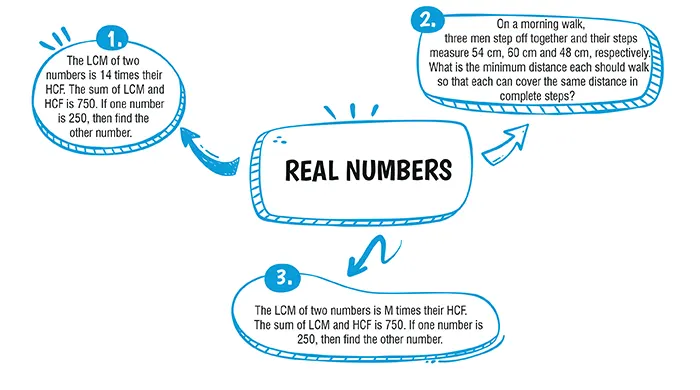Table of Contents

Ans. (b)
Explanation:
Prime factorization is the method of representing a number as the multiplication of its prime factors. A number qualifies as prime if it possesses solely two factors , 1 and the number itself.Here's a breakdown of the sequential procedure for identifying the prime factors in the prime factorization of 196:
Prime factors of 196 = 2^2 \space × \space 7^2 \\
So, sum of exponents = 2+2=4
(a) 1
(b) 0
(c) 2
(d) 3
Ans. (c)
Explanation:
As we know that prime numbers are the numbers with two factors, 1 and the number itself.
∴ Total number of factors of a prime number will be 2.
Explanation:
Let HCF be H.
Then LCM = 14H
Now, sum of LCM and HCF is 750. [Given]
∴ 14H + H = 750
⇒ 15H = 750
⇒ H \space = \space \frac{750}{15} \\
⇒ H = 50
∴ LCM = 14H = 14 × 50 = 700
We know that,
Product of LCM and HCF = Product of two numbers.
Then, 700 × 50 = 250 × y
⇒ \space\space\space\space y \space = \space \frac{700 × 50}{250}\\
⇒ Y \space = \space 140
Hence, the other number is 140.
Explanation:
The minimum distance that each should walk is the LCM of 54, 60 and 48.
Now, \space\space\space\space\space 54 = 2 × 3^3 \\
\space\space\space\space\space\space\space\space\space\space\space 60 = 2^2×3×5 \\
\space\space\space\space\space\space\space\space\space\space\space 48 = 2^4 × 3 \\
∴ \space\space\space\space\space LCM (54, 60, 48) \space = \space 2^4 × 3^3 × 5 = 2160 \\
∴ \space\space\space\space\space \text{Required distance = 2160 cm} \\
\space\space\space\space\space\space\space\space\space = \space 21 m 60 cm
Explanation:
Let HCF be ‘H’
Then LCM = 14H sum of LCM and HCF is 750.
∴ 14H + H = 750
⇒ 15H = 750
\Rightarrow \space\space\space\space \text{H} =\large\frac{750}{15}\\
⇒ H = 50
∴ LCM = 14H
= 14 × 50 = 700
We know
Product of LCM and HCF = Product of two numbers.
Let other number be y
Then,
700 × 50 = 250 × y
⇒ \text{y} = \large\frac{700 × 50}{250}
⇒ y = 140
Hence, the other number is 140.
| Chapter No. | Chapter Name |
|---|---|
| Chapter 1 | Real Numbers |
| Chapter 2 | Polynomials |
| Chapter 3 | Pair of Linear Equations in Two Variable |
| Chapter 4 | Quadratic Equations |
| Chapter 5 | Arithmetic Progressions |
| Chapter 6 | Triangles |
| Chapter 7 | Coordinate Geometry |
| Chapter 8 | Introduction to Trigonometry |
| Chapter 9 | Some Applications of Trigonometry |
| Chapter 10 | Circles |
| Chapter 11 | Areas Related to Circle |
| Chapter 12 | Surface Areas and Volumes |
| Chapter 13 | Statistics |
| Chapter 14 | Probability |
| Chapter Wise Important Questions for CBSE Board Class 10 Maths |
|---|
| Real Numbers |
| Polynomials |
| Pair of Linear Equations in Two Variables |
| Quadratic Equations |
| Arithmetic Progressions |
| Triangles |
| Coordinate Geometry |
| Introduction to Trigonometry |
| Some Applications of Trigonometry |
| Circles |
| Areas Related to Circles |
| Surface Areas and Volumes |
| Statistics |
| Probability |
CBSE Important Questions Class 10
ICSE Important Questions Class 10
CBSE Important Questions Class 10
ICSE Important Questions Class 10